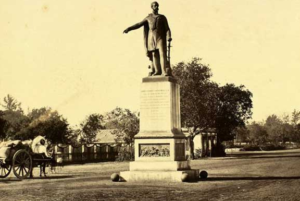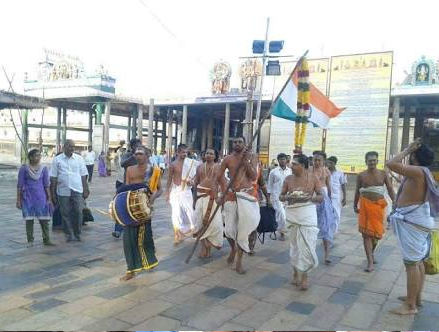
In the aftermath of the Second World War, post-colonial regimes in Africa and Asia hauled down imperial iconography, in an effort to sweep away remnants of their colonial heritage. The removal of British imperial statues from India’s public spaces was more widespread after the tricolour was unfurled. But Madras perhaps was the first place in the empire to agitate and remove a British statue and that too, a decade before freedom dawned.
According to reports in The Hindu, at 9 a.m., on August 11, 1927, two men walked calmly on Mount Road (now called Anna Salai) in the morning. One carrying a bag of tools, the other an axe and they carried a ladder. Even the policeman directing traffic at Spencer’s junction mistook them for workmen. The duo walked to the middle of the road, placed the ladder on a 22-foot statue opposite Spencer’s Building and climbed up the pedestal. The two were not workmen but were Congress volunteers from Madurai, Mohammed Saliah and Subbarayulu. Once up the pedestal, they started shouting slogans. One took out a hammer and chisel from his tool bag and started hitting the statue. The other took swinging blows with an axe. Chips of metal and mortar were strewn around. People and police started crowding around the statue. Addressing assembling crowds, the two raged against the atrocities committed by Colonel Neil and demanded that the statue be removed. After the two activists shouted anti-British slogans and could do no more harm to the bronze statue, they were brought down, arrested and sentenced to six months rigorous imprisonment.
The statue was of James Neil of the Madras Fusiliers Regiment, who played a major role in putting down the 1857 War of Independence. He was killed minutes before the Fusiliers won their greatest victory, but not before he disposed of quite a few Indians in cruel methods.
While celebrated by the imperial government as a martyr, the colonel earned notoriety among Indians as a brutal officer and his sobriquet of ‘Butcher of Allahabad (or Lucknow)’. Luckily for Neil and his memory, one of the members of his Fusiliers happened to be the Governor of Madras, Harris. He formed a committee to erect a memorial which exhorted the public to contribute. Rs 18,953 was collected by November 1858, but not enough for an equestrian statue, (two statues had to be made, one in Ayr, Scotland) and so the design was changed to a position where he was seen standing with his sheathed sword.
When the 10-foot bronze statue of Colonel James Neil was perched on a 12-foot pedestal near the Spencer building on Mount Road in 1861, everything that bordered it was insignificant in its imposing presence. On the pedestal was an inscription, “universally acknowledged as the first who stemmed the torrent of rebellion.”
Neil was celebrated by the imperial government as a martyr but with the Indian independence movement gaining momentum, the statue, as an emblem of colonial oppression, became an affront.
Historian A.R Venkatachalapathy explains that the statue of James Neil was a prime opportunity for the Congress to further its nationalist cause. “Neil was an especially vicious general and the prominence of the statue was ideal for rallying support.”
The Neil statue campaign and the conviction of the two activists became a sensation with people across the State mobilising in support. By September 1927, as many as 21 people had been arrested, including women and children. Ammapon alias Leelavathi was 11 years old when she took part in Neil statue Satyagraha. Even the Tribune, a Lahore-based daily weighed in with its support.
Satyamurti, Congress leaders, said that Neil was a “monster in human form whose statue disfigures one of the finest thoroughfares in Madras”. The Madras Mahajana Sabha and the Indian National Congress passed resolutions demanding its removal and started a series of demonstrations in Madras. Several agitators were arrested and sentenced to prison terms.
With many of the leaders in jail, K. Kamaraj was entrusted with the task of leading the Satyagraha. The Neil agitation led to the emergence of Kamaraj to the forefront. Before embarking on the protest, Kamaraj took the blessings of Mahatma Gandhi, who for his part gave his blessings with the condition that the protests must conform to the principles of Satyagraha and insisted that non-violence had to be upheld. “Instead of hammers, the use of clay balls may be more appropriate” he suggested.
Inspite of Kamaraj’s agitations Neil’s statue remained in the same place till 1937. When the newly elected Congress government (under the 1935 act) came to power, C. Rajagopalachari decided to do a balancing act between the ruling British and the agitating nationalists.
“There are more ways than one of keeping a historic monument or memorial,” was Rajaji’s cryptic remark. He moved a resolution in the Madras Corporation demanding its removal and then on one night the deed was done. People crossing Mount Road were surprised at the empty space the next day. The statue was in Ripon Building for the transit before being moved to the Madras Museum.
The statue can still be seen in the Anthropology section of the Madras museum, however, near a hand rickshaw model and generations of visitors have wondered on the nonexistent connection. Once a symbol of colonial might, it now stands displayed as benign memorabilia, belying an insolent past.

